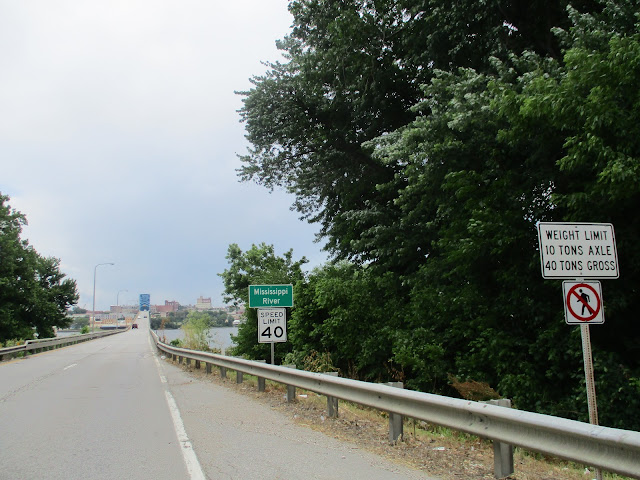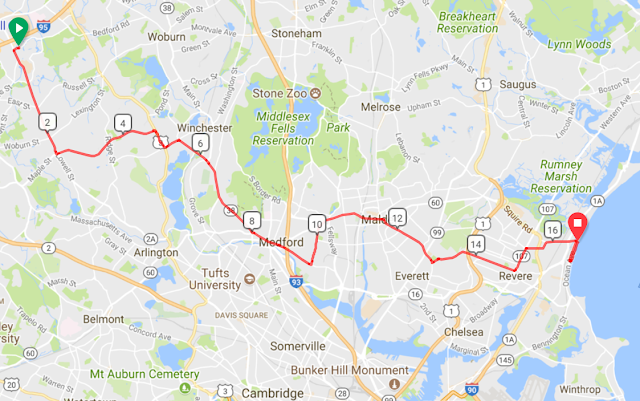Day 30 - Sunday, June 10th - Kirksville, MO to Quincy, IL
Distance: 75.9 miles
Elevation Gain: 1669 ft.
or 22.0 ft./mile
Our distance today was about the same as yesterday as we
headed east-southeast and crossed the Mississippi for our seventh state line crossing and our eighth state. We also passed the 2000 mile mark for the tour leaving about
1400 to go. The weather wasn't quite as hot especially as we got passed the half way point and the sun gave way to clouds and even rain for a five mile stretch. A couple of isolated claps of thunder had us scanning the sky and looking for cover if needed. Fortunately, it wasn't. We spent all but five miles in Missouri but unlike the past three days, the early rollers were easier and flattened out at about mile 25. The whole day was a gradual decline in elevation with the exception of a short climb after getting across the Mississippi.
Out of the hotel we headed east on MO-6 (Shepard Ave.) and reached Brashear at mile 11. Brashear is a small town of 270 people that was laid out in 1872 and named after Richard Matson Brashear, a prominent farmer, businessman and the son of one of the first white settlers in the area.
Out of the hotel we headed east on MO-6 (Shepard Ave.) and reached Brashear at mile 11. Brashear is a small town of 270 people that was laid out in 1872 and named after Richard Matson Brashear, a prominent farmer, businessman and the son of one of the first white settlers in the area.
Next up at mile 15 was Hurdland,
a village of about 160 people that was laid out in 1872 when the railroad was
extended to this point. It is named after John Hurd, the original owner of the
town site.
At mile 22 the road turned north as we headed to Edina, a city of nearly 1200 people and
the county seat of Knox County. Laid out in 1839 it is named after Edinburgh,
Scotland in the manner in which Scottish poets refer to Edinburgh.
Here are some pictures from the ride into Edina.
Here are some pictures from the ride into Edina.
The road turned southeast at mile 28 and at mile 32 we reached Knox City, a village of 200 people laid out in 1872…when the
railroad reached this point. It also was the location of out only SAG stop.
Mile 38 brought us to La
Belle, a small town of about 650 people founded in 1857. Its name is
derived from the French meaning “the beautiful” and was so named for its scenic
setting. Based on my memory and these two pictures "scenic" is not what comes to mind.
Mile 43 brought us to Lewistown,
a town of 500 founded in 1871…when the railroad reached this point, and the
town took its name from Lewis County where it is located.
Mile 52 had us at Ewing, a town of about 450 and is named after William Ewing, a pioneer citizen. James Earl Ray, the assassin of Martin Luther King Jr. lived here from ages 7 to 16. It was in this stretch that I was getting rained on and otherwise preoccupied so Ewing came and went without an pictures.
Mile 52 had us at Ewing, a town of about 450 and is named after William Ewing, a pioneer citizen. James Earl Ray, the assassin of Martin Luther King Jr. lived here from ages 7 to 16. It was in this stretch that I was getting rained on and otherwise preoccupied so Ewing came and went without an pictures.
Another 18 miles and we were in West Quincy, our last stop in Missouri. As outposts go this is different
as it is solely a commercial area with no permanent residents. It is home to a
number of gas stations that service residents of Quincy, Illinois. It seems
Missouri has lower taxes on gasoline and cigarettes. During a flood in 1993,
the levee was sabotaged and the floodplain filled. A barge was sucked into
the break in the levee and hit one of the gas stations causing an explosion.
All the Quincy bridges, the only links between Missouri and Illinois for over
200 miles, were closed. One of the bridges was closed for 71 days.
No pictures of West Quincy...it looks like every other truck stop you have seen just off the interstate. From there we went across the Mississippi and into
No pictures of West Quincy...it looks like every other truck stop you have seen just off the interstate. From there we went across the Mississippi and into
Quincy also happen to be home to some really beautiful old homes.
Sneak Peek at Tomorrow
107 miles to Springfield, IL, the land of Lincoln, that looks to have some small climbs and rollers that go flat after we cross the Illinois River at mile 45. The distance should be more of a factor than the climbing.
Springfield, the
capital of Illinois and the county seat of Sangamon County with a population of
over 115,000. The city was settled originally by trappers and traders that came
to the Sangamon River in 1818 and its first cabin was built in 1820 by John
Kelly. The city was originally named Calhoun, after Senator John C Calhoun of
South Carolina who was also the seventh Vice President of the US. By 1832
Calhoun had fallen out of favor with the public and the town renamed itself
after Springfield MA which was the silicon valley of its time and residents
were looking to emulate it. Springfield was home to Abraham Lincoln from 1837
until 1861 when he was elected President.
Barrack Obama used the state capitol to announce his candidacy and later
to announce Joe Biden as his running mate.




































Comments
Post a Comment